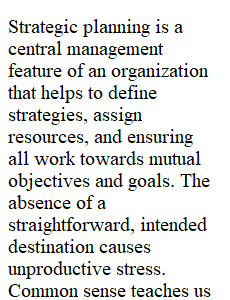


Q Creating a compelling vision and developing a strategy to achieve it is one of leadership’s primary functions. Historically, only top leaders understood the organization’s vision well enough to organize human and material resources to achieve it. Today, however, leaders at every level of the organization must understand the vision. Strategic leadership and excellence in organizational performance does not come about by accident. It is a conscious choice made by organizational leaders. Top leaders know their organization’s environment, have a five- or ten-year vision for the organization, and set believable plans to achieve their vision. However, in this complex and ever-changing world, anticipating the future can be very difficult. This complexity explains why many leaders are more comfortable focusing on clear, short-term goals than on uncertain, long term visions. Therefore, leaders must keep their focus on the long-term vision as daily tasks that meet the long-term goals of the organization. Leadership gets their marching orders from the mission statement. The mission statement sets the purpose of the company. Here is Alphabet’s mission statement: “Organize the world’s information and make it universally accessible and useful” (Google, n.d., para. 1). Alphabet’s vision statement is “to provide access to the world’s information in one click” (Thompson, 2015, para. 3). As you can see, the vision statement is a long term outlook. Alphabet’s mission and vision statements are aligned, which is important. As you imagine yourself as the leader or CEO of Alphabet, which would you want to base your quarterly or annual goals on – the mission statement, or the vision statement? References Google. (n.d.). Company – Google (Links to an external site.)Links to an external site.. Thompson, A. (2015). Google’s vision statement and mission statement (Links to an external site.)Links to an external site.. Prompt Write a 2-3 page paper examining the importance of leadership vision to the leader and to the organization. Examine the consequences of a leader without a vision and an organization without a vision. Consequences may relate to the organization internally, as well as relationships with vendors, shareholders, customers, or clients. Explain how the mission statement helps drive the vision of a company. Tasks Assess the importance of vision to the leader and to an organization. Evaluate the consequences of a leader without vision and an organization without a vision. Use the EC Library guide to conduct your research: Business Research Guide (Links to an external site.)Links to an external site.
View Related Questions